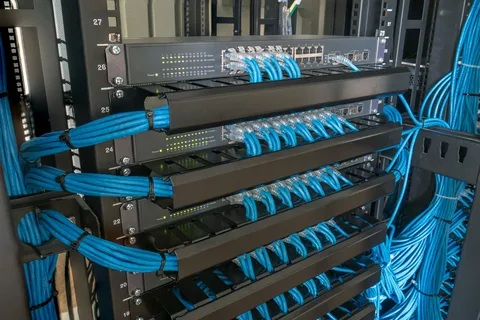In today’s IT world, efficiently organizing and protecting crucial equipment isn’t just nice to have—it’s absolutely essential. Without a solid infrastructure, your valuable servers, networking gear, storage devices, and other sensitive electronics can quickly turn into a disorganized mess, risking overheating, management headaches, and potential damage.
This is where server racks and network racks become indispensable. These standardized frames offer a secure, scalable, and highly organized way to house your vital IT equipment. This guide will walk you through choosing the ideal rack solution, ensuring your valuable gear stays organized, protected, cool, and performs optimally for years to come.
What Are Server And Network Racks?
At their core, server and network racks are standardized structures designed to mount, organize, and protect IT equipment. They are essentially industrial-grade shelving units, but with precise dimensions and features explicitly built for electronic hardware. The industry standard for mounting width is 19 inches, defined by the Electronic Industries Alliance (EIA-310-D), ensuring compatibility across different manufacturers’ equipment. Their primary purpose is to provide a stable, contained, and often secure environment that optimizes the performance and lifespan of your IT assets.
Why Are Racks Essential For Your IT Infrastructure?
Implementing the right rack solution offers a multitude of benefits that directly impact the efficiency and longevity of your IT setup:
- Organization and Space Efficiency
Racks consolidate multiple pieces of equipment into a compact vertical footprint, saving valuable floor space in server rooms or offices. They also significantly improve cable management, transforming spaghetti-like tangles into neat, accessible pathways.
- Optimized Cooling and Airflow
IT equipment generates heat. Racks are designed with airflow in mind, facilitating proper ventilation and supporting active cooling solutions like rack-mounted fans or targeted air conditioning. This prevents overheating, which is a significant cause of hardware failure.
- Physical Securit
Enclosed cabinet racks come with lockable front and rear doors, and often side panels, deterring unauthorized access and theft. They also protect sensitive equipment from accidental bumps, dust, and environmental factors.
- Scalability and Future Growth
As your business grows, your IT needs evolve. Racks are built for easy expansion; you can add or remove equipment as required. Their standardized sizing ensures that new hardware will fit seamlessly.
- Simplified Maintenance and Troubleshooting
With equipment neatly organized and cables properly routed, IT professionals can easily access components for maintenance, upgrades, or troubleshooting, reducing downtime and effort.
- Professional Appearance
A well-organized rack system presents a clean, professional image for your IT infrastructure, whether it’s in a dedicated data center or a small office.
Key Considerations When Choosing A Rack Solution
Selecting the perfect rack involves careful planning to match its capabilities with your current and future needs.
- Height (U or RU)
This is measured in “rack units” (U or RU), where 1U equals 1.75 inches (44.45 mm). To determine the height you need, add up the U-heights of all your current equipment and factor in extra space for future expansion, accessories like patch panels, or blanking panels. Standard sizes range from small 6U or 12U racks for closets to full-height 42U or 48U racks for data centers.
- Width
The internal mounting width is universally 19 inches. However, the external width of the rack can vary, with some wider options (e.g., 23 inches) providing additional space for vertical cable management or specialized equipment.
- Depth
This is crucial, especially for modern servers which can be pretty deep. Measure the deepest piece of equipment you plan to install and add generous extra space for front and rear cabling, power distribution units (PDUs), and proper airflow. Standard rack depths include 600mm, 800mm, 1000mm, and 1200mm (approximately 24″, 36″, 42″, and 48″ respectively).
Cooling And Airflow Management
Adequate cooling is vital for equipment longevity.
- Ventilation
Look for racks with high percentages of perforation (typically 70-80% or more) on the front and rear doors to allow for efficient air intake and exhaust.
- Fans
Many racks include or support the addition of top-mounted fan trays or individual rack-mounted fans to assist with airflow.
- Cable Management
Proper cable routing prevents cables from blocking air pathways, ensuring smooth airflow.
- Hot/Cold Aisle Containment
For larger data centers, advanced strategies like hot aisle or cold aisle containment can optimize cooling efficiency.
Weight Capacity
Always check the static and dynamic load ratings of the rack. The static load refers to the maximum weight the rack can hold when stationary, while the dynamic load refers to the maximum weight it can support when being moved (if it has casters). Ensure the rack can comfortably support the total weight of all your mounted equipment, including PDUs and accessories.
Security Features
For sensitive or valuable equipment, security is key. Look for racks with robust lockable front and rear doors, and secure side panels. Some advanced racks may even offer compatibility with electronic access control systems.
Cable Management Options
Efficient cable management is crucial for airflow, accessibility, and neatness. Look for racks with built-in vertical and horizontal cable managers, cable rings, and options for cable ties or Velcro straps. Ensuring proper bend radius for cables prevents damage and signal loss.
Accessibility
A well-designed rack allows for easy access to equipment. Features like removable side panels, hinged front and rear doors, and adjustable mounting rails simplify installation and maintenance. Casters (wheels) are invaluable for mobility, allowing you to move the rack for rear access or relocation.
Accessories And Power Distribution
Don’t forget the ecosystem of accessories:
- PDUs (Power Distribution Units)
Essential for providing power outlets within the rack. They come in various forms (basic, metered, switched, monitored) and orientations (vertical or horizontal).
- Shelves
Fixed or sliding shelves are needed for equipment that isn’t rack-mountable.
- Blanking Panels
These cover empty U-space, improving airflow by preventing hot air recirculation.
- Cable Organizers
Additional tools to keep cables tidy.
Typical Applications And Best Practices
Understanding where and how different types of racks are best utilized is key to making the right choice for your specific environment.
- Small Office/Home Office (SOHO)
For limited equipment, a compact wall-mount rack (6U-12U) or a small enclosed cabinet (6U-18U) is often sufficient. Prioritize quiet operation and space efficiency.
- Server Rooms/IT Closets
Medium to large enclosed cabinets (24U-42U) are common here. Focus on good ventilation, robust security, and effective cable management to support a growing number of devices. Open frame racks can also be suitable if physical access is controlled at the room level.
- Data Centers
Full-height (42U-48U) enclosed cabinets are standard. Here, advanced cooling strategies like hot/cold aisle containment, high-capacity PDUs, and robust security features become paramount.
Best Practices For Optimal Rack Setup
Setting up your server and network rack correctly is just as important as choosing the right one. A well-planned and organized rack not only looks professional but also significantly improves performance, simplifies maintenance, and extends the life of your valuable IT equipment. By following these best practices, you can ensure your rack setup is efficient, reliable, and ready for future growth.
- Plan Ahead
Always map out your equipment placement before installation, considering airflow, cable paths, and future expansion.
- Leave Space
Don’t fill every U-space. Leave 1U of empty space between heat-generating devices when possible, or use blanking panels to guide airflow.
- Proper Cabling
Invest in good quality, appropriate length cables and use cable management accessories to keep them neat and out of the way of fans and vents.
- Label Everything
Labeling cables, patch panels, and equipment makes maintenance and troubleshooting significantly easier.
- Monitor Environment
Consider adding environmental monitoring (temperature, humidity sensors) to alert you to potential cooling issues.
Conclusion
Choosing the correct server and network rack is a foundational decision that impacts the efficiency, security, and longevity of your entire IT infrastructure. By carefully considering factors such as size, rack type, cooling capabilities, weight capacity, and essential accessories, you can make an informed decision that perfectly aligns with your operational needs and budget. A well-selected and adequately set up rack isn’t just a housing unit; it’s a strategic investment that safeguards your valuable equipment, ensures optimal performance, and provides a professional, scalable foundation for your digital operations.
Optimize Your IT Space: Explore Rack Solutions!
Ready to enhance the organization, security, and performance of your IT equipment? Selecting the ideal server or network rack is a critical step towards a more efficient and reliable infrastructure. For a comprehensive selection of high-quality rack solutions, including cabinets, open frames, and essential accessories, designed to meet diverse IT needs, explore trusted providers. Visit www.se.com to discover the perfect rack to optimize your data center, server room, or office setup.
Frequently Asked Questions
- What are the key benefits of using blanking panels in a rack, beyond just aesthetics?
Beyond aesthetics, blanking panels are crucial for thermal management as they prevent hot exhaust air from the rear of the rack from recirculating back to the front and being ingested by equipment, thus ensuring that all devices receive a consistent supply of cool intake air.
- How often should I review and re-evaluate my rack setup as my IT needs change?
It is advisable to review and re-evaluate your rack setup at least once a year, or whenever there is a significant change in equipment, a noticeable increase in heat, or a planned expansion of your IT infrastructure, to ensure continued efficiency and optimal performance.
- Can I mix different brands and sizes of equipment within the same 19-inch rack?
Yes, you can absolutely mix different brands and U-sizes of equipment within the same 19-inch rack because the 19-inch standard ensures universal compatibility for mounting width, although you may need specific rail kits or shelves for non-rack-mountable devices.
- What are some common mistakes to avoid when installing equipment into a server or network rack?
Common mistakes to avoid include overloading the rack’s weight capacity, neglecting proper cable management which can hinder airflow and accessibility, failing to use blanking panels, ignoring front-to-back airflow requirements, and not planning for future growth, which can lead to quick obsolescence.
- Is proper grounding necessary for all equipment mounted in a rack, and why?
Yes, proper grounding is essential for all equipment mounted in a rack for both safety and performance reasons, as it provides a safe path for fault currents in case of an electrical issue, protecting personnel and equipment from electrical shocks, and helps to reduce electromagnetic interference (EMI) that can affect data integrity.





Be First to Comment